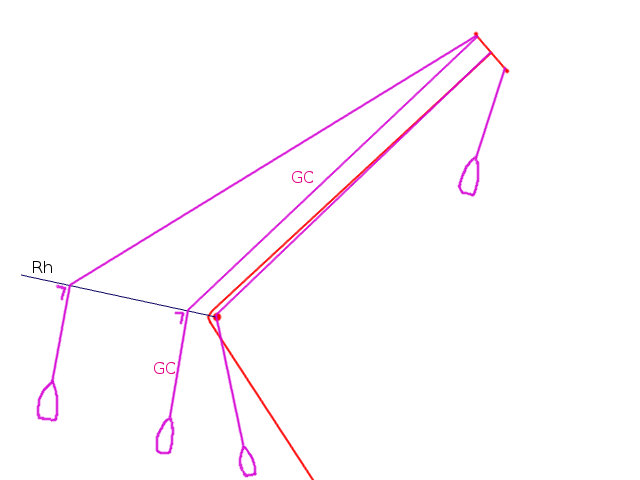Frequently Asked Questions
Q. WAATA? (What are all these acronyms?)
A. SOL - Sailonline
DC - Delayed Command
DBL - Distance Behind Leader
DTF - Distance To Finish
POI - Point of Interest (as a waypoint on a chart)
IRL - In Real Life
WX - Weather Update
PR - Practice Race
BBQ - Barbeque, which is why you hit the beach, right?
SOTP - Seat Of The Pants sailing, i.e. not using routing software
QT - qtVlm routing software
AGL - Auto Grib Loader and DC Checker tool to help navigation. See this Forum entry
KoD - Kiss of Death (when you're in first place in an early part of the race)
MM - Maker's Mark
Q. Why is there a "boat shadow" following me?
A. The thicker-line boat is the most recent update of your boat position. The one that lags a bit is the boat position corresponding to the update of the rest of the fleet; the fleet is updated less frequently than your own boat.
Q. How do I know when I've rounded a mark?
A. Rounding is accomplished when you've crossed a line that bisects the course-change angle on the correct side of the mark. If you've crossed it on the wrong side, you have to go back and cross in the other direction on the same wrong side, and then cross on the correct side. Once you've rounded, the mark should say "Rounded" on the screen. If your DTF keeps increasing as you get closer to the next mark, it means there's some previous mark you haven't actually rounded (check all of them).
Q. How is DTF calculated?
A. Add up consecutive distances to the lines bisecting the course-change angles (on the correct side), and then to the nearest point on the finish line. Distances use great-circle calculations, ignoring land. Kroppyer drew an illustration:

Q. What tools should I know about?
A. Look through the links in Sailonline's Links section. If you use a routing tool, you'll most likely need brainaid's website to get current race info (polars, weather gribs, etc.). Many SOLers also use the Java-based AGL tool (some familiarity with the command line is helpful, especially when trying to install on Macs). Also, WX Inspector, but it's written in Flash so you need extra steps to use it.
Q. What are the formulas for Performance Loss for tacks, gybes, and other course changes?
A. kroppyer explains it all in this PDF:
http://www.sailonline.org/static/var/sphene/sphwiki/attachment/2013/12/21/SOL_performance_loss.pdf
Q. What routing software is available?
A. The most commonly used on SOL is qtVlm. If you're on the Apple platform, also check out LuckGrib (and also check out their website's comprehensive routing reference section). If you already have Expedition or Adrena from real-boat use, those work well, too (PC only).
Q. I like qtVlm, it's donation-ware for PCs, Macs, Linux, and even Raspberry! And freemium on mobile devices. How do I start?
A1. kroppyer can help: http://solfans.org/blog/routing/qtvlm/introduction-to-qtvlm/
A2. Dingo's help file in the Sailonline Forum
A3. Satori's help file
Q. My routing results on qtVlm don't match what I see in the Sailonline app, is it a bug?
A. Starting with the least obvious, check the following:
- qtVlm Preferences->Advanced->Grib interpolation is set to SOL
- qtVlm Preferences->Advanced>Gshhs coastlines matches the race resolution (see the Info tab)
- You have good settings in the qtVlm Boat->Boat Settings->Engine and Tacks/Gybes section (no engine use, and some penalty for tacks and gybes that approximates the performance loss in SOL)
- You have imported the correct polar file in boat settings into qtVlm
- You have imported the latest weather update into qtVlm
- Remaining items that can't be fixed:
- qtVlm can't take into account performance loss from directional changes that don't include a tack or gybe
- Server timing for executed commands, which can be 10-30 secs off from your request; these uncertainties can accumulate over many maneuvers
Q. Can I get longer-range weather for routing?
A. Yes, the GFS model goes out to 16 days. Available from NOAA, but for practical use:
- The AGL tool provides options to download those gribs, either as the full 16 days, or just the period after the SOL grib
- Routing software like Expedition, Adrena, LuckGrib, and others, also provide methods for getting this data
- If using qtVlm, here's how to get the 16 day forecasts using their Saildocs request:
- Select the area on screen where you want weather (click on the square selection tool in the toolbar)
- From the Grib menu, select Grib Saildocs
- Check the box for GFS, ask for Wind (10m), then I recommend 2.5º, 3h, for 16 days
- Press Send Mail
- This should open up a window in your mail program, ready to send out. You can adjust parameters (the syntax is very precise), and send it; you can also set qtVlm preferences to send the email out directly through its own servers (check the Internet section of qtVlm preferences)
- You should receive an email back with the grib in under one minute (the email also includes lots of info about using saildocs)
- Save the grib, and load it from qtVlm into slot 2 (assuming you use slot 1 for the SOL grib)
- qtVlm will use the finest-grained grib at every point in time; if two gribs have the same resolution, it will use the lowest slot number; so if you have a 7-day 1º SOL grib in Slot 1 and a 16-day 1º Saildocs grib in slot 2, it will use the SOL grib for the first 7 days, and then the Saildocs grib for the remaining 9 days
Q. Are there any unwritten rules one should know about?
A. Yes, some are written here: http://gaidano.eu/page4.php
Essentially:
- Never sleep
- Cover the fleet
- Foot toward the wind shift
- Always go around the outside
- Beware the KoD (see Q1 above)
- See rule #1